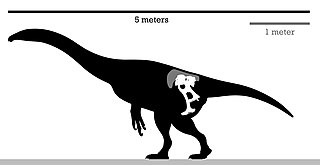
Enigmosaurus is a genus of therizinosauroid that lived in Asia during the Late Cretaceous period. It was a medium-sized, ground-dwelling, bipedal herbivore that represents the third therizinosaur taxon from the Bayan Shireh Formation, although it is known from the lower part. The genus is monotypic, including only the type species E. mongoliensis, known from a well preserved pelvis and other tentative body remains.

Garudimimus is a genus of ornithomimosaur that lived in Asia during the Late Cretaceous. The genus is known from a single specimen found in 1981 by a Soviet-Mongolian paleontological expedition in the Bayan Shireh Formation and formally described in the same year by Rinchen Barsbold; the only species is Garudimimus brevipes. Several interpretations about the anatomical traits of Garudimimus were made in posterior examinations of the specimen, but most of them were criticized during its comprehensive redescription in 2005. Extensive undescribed ornithomimosaur remains at the type locality of Garudimimus may represent additional specimens of the genus.

Alectrosaurus is a genus of tyrannosauroid theropod dinosaur that lived in Asia during the Late Cretaceous period, about some 96 million years ago in what is now the Iren Dabasu Formation.

Achillobator is a genus of large dromaeosaurid theropod dinosaur that lived during the Late Cretaceous period about 96 million to 89 million years ago in what is now the Bayan Shireh Formation of Mongolia. The genus is currently monotypic, only including the type species A. giganticus. The first remains were found in 1989 during a Mongolian-Russian field expedition and later described in 1999. Remains at the type locality of Achillobator may represent additional specimens. It represents the first and largest dromaeosaurid known from the Bayan Shireh Formation.
Maleevus is an extinct genus of herbivorous ankylosaurid dinosaur from the late Cretaceous, around 90 million years ago, of Mongolia.

The Bayan Shireh Formation is a geological formation in Mongolia, that dates to the Cretaceous period. It was first described and established by Vasiliev et al. 1959.

Amtosaurus is a genus of ornithischian dinosaur based on a fragmentary skull collected from the Upper Cretaceous Bayan Shireh Formation of Mongolia and originally believed to represent an ankylosaurid. Hadrosaurid affinities have also been suggested. However, per Parish and Barrett, this specimen is too fragmentary to be reliably classified beyond an indeterminate ornithischian. A second species assigned to the genus, A. archibaldi, has become the basis of a valid ankylosaurid taxon, Bissektipelta.
Shamosaurus is an extinct genus of herbivorous basal ankylosaurid ankylosaur from Early Cretaceous deposits of Höövör, Mongolia.

Tarchia is a genus of herbivorous ankylosaurid dinosaur from the late Cretaceous of Mongolia.

Talarurus is a genus of ankylosaurid dinosaur that lived in Asia during the Late Cretaceous period, about 96 million to 89 million years ago. The first remains of Talarurus were discovered in 1948 and later described by the Russian paleontologist Evgeny Maleev with the type species T. plicatospineus. It is known from multiple yet sparse specimens, making it one of the most well known ankylosaurines, along with Pinacosaurus. Elements from the specimens consists of various bones from the body; five skulls have been discovered and assigned to the genus, although the first two were very fragmented.

Graciliceratops is a genus of neoceratopsian dinosaurs that lived in Asia during the Late Cretaceous period.
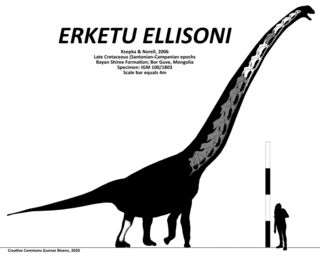
Erketu is a genus of somphospondylan sauropod dinosaur that lived in Asia during the Late Cretaceous roughly between 96 million and 89 million years ago. Its fossils were found in Mongolia between 2002 and 2003 during a field expedition and first described in 2006; later on in 2010 due to some cervicals that were left behind in the expedition. Erketu represents one of the first sauropods described from the Bayan Shireh Formation. The elongated cervical vertebrae of Erketu indicates that it was the sauropod with the longest neck relative to its body size.
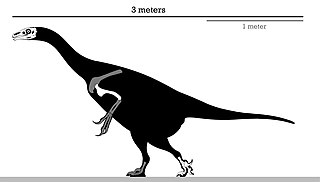
Erlikosaurus is a genus of therizinosaurid that lived in Asia during the Late Cretaceous period. The fossils, a skull and some post-cranial fragments, were found in the Bayan Shireh Formation of Mongolia in 1972, dating to around 96 million and 89 million years ago. These remains were later described by Altangerel Perle and Rinchen Barsbold in 1980, naming the new genus and species Erlikosaurus andrewsi. It represents the second therizinosaur taxon from this formation with the most complete skull among members of this peculiar family of dinosaurs.

The Barun Goyot Formation is a geological formation dating to the Late Cretaceous Period. It is located within and is widely represented in the Gobi Desert Basin, in the Ömnögovi Province of Mongolia.
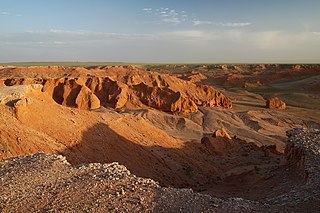
The Djadochta Formation is a highly fossiliferous geological formation situated in Central Asia, Gobi Desert, dating from the Late Cretaceous period, about 75 million to 71 million years ago. The type locality is the Bayn Dzak locality, famously known as the Flaming Cliffs. Reptile and mammal remains are among the fossils recovered from the formation.
The Iren Dabasu Formation is a Late Cretaceous geologic formation in the Iren Nor region of Inner Mongolia. Dinosaur remains diagnostic to the genus level are among the fossils that have been recovered from the formation. The formation was first described and defined by Henry Fairfield Osborn in 1922 and it is located in the Iren Nor region of China.
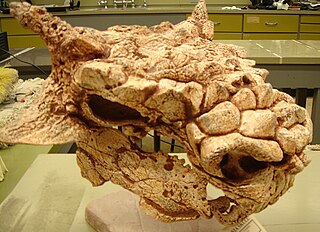
Minotaurasaurus is a monospecific genus of ankylosaurid dinosaur that lived in Mongolia during the Late Cretaceous in what is now the Djadochta Formation. The type and only species, Minotaurasaurus ramachandrani, is known from two skulls, a cervical vertebra and a cervical half ring. It was named and described in 2009 by Clifford Miles and Clark Miles. The first fossils of Minotaurasaurus were illegally exported out of Mongolia.It has been suggested to be a synonym of Tarchia but more recent publications consider it as a distinct genus.

Tsagandelta is a genus of deltatheroidean therian mammal that lived in Asia during the Late Cretaceous. Distantly related to modern marsupials, it is part of Deltatheroida, a lineage of carnivorous metatherians common in the Cretaceous of Asia and among the most successful non-theropod carnivores of the region. It represents the first known mammal from the Bayan Shireh Formation.

Gobihadros is a genus of basal hadrosauroid dinosaur that lived in Asia during the Late Cretaceous period in what is now the Bayan Shireh Formation (Cenomanian-Santonian). It contains only the type species Gobihadros mongoliensis. It has an estimated length of 7.5 m (25 ft).

Natovenator is a genus of halszkaraptorine dromaeosaurid dinosaur from the Late Cretaceous Barun Goyot Formation of Mongolia. The genus is known from a single species, N. polydontus. Natovenator is crucial to the understanding of halszkaraptorines due to it providing more support for the semi-aquatic lifestyle that has been proposed for this clade. This discovery is important as the semi-aquatic lifestyles of halszkaraptorines was contested in early 2022.






















